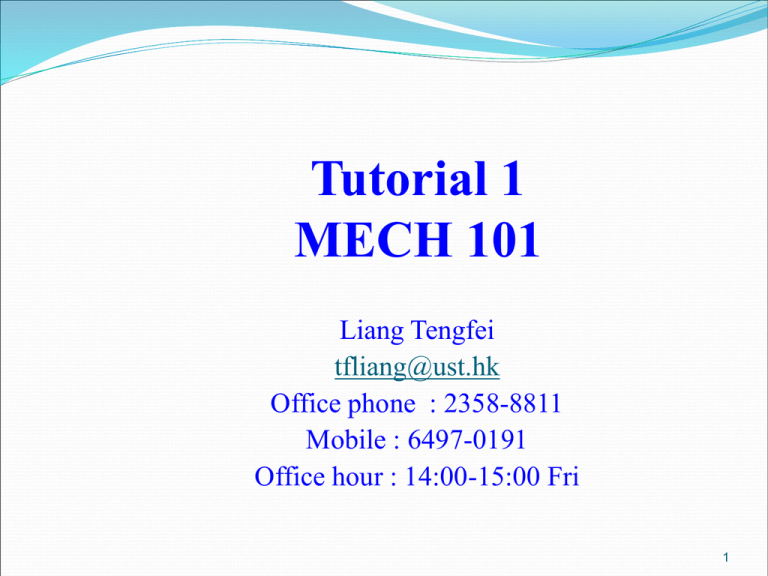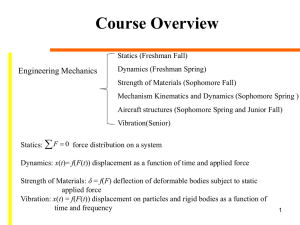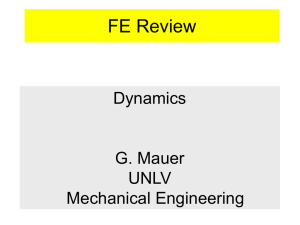MECH101 Tutorial 1
advertisement

Tutorial 1 MECH 101 Liang Tengfei tfliang@ust.hk Office phone : 2358-8811 Mobile : 6497-0191 Office hour : 14:00-15:00 Fri 1 Outline Cartesian vector calculation(+ • ×) 2D forces equilibrium problem Moment calculation Reduction of force system 2 Express a Force as a Cartesian Vector Magnitude + direction (daily life) a Cartesian Vector (statics analysis) Fy F cos(60) 200 0.5 100( N ) Fz F cos(45) 200 0.707 141.4( N ) Fx F cos( ) ? z Fz F=200N F 2 Fx 2 Fy 2 Fz 2 45۫ Fx 60۫ [ F cos(60)]2 [ F cos(45)]2 [ F cos( )]2 Fy F 2 [cos(60)2 cos(45)2 cos( )2 ] y x cos(60) 2 cos(45)2 cos( )2 1 600 3 Exercise 1 + : resultant force F1=3 i-5 j+7 k , F2=-9 i+4 j-3 k F1+F2=?-6 i-1 j+4 k • : Projection F1=3 i-5 j+7 k, e =0.6 j-0.8 k F1 • e=?-8.6 ×: Moment F1=3 i-5 j+7 k, r =-9 i+4 j-3 k r×F1=? i j k C ( Ax i Ay j Az k ) ( Bxi By j Bz k ) Ax Ay Az Bx By Bz Pay attention to the order of the vector. i j k r F 9 4 3 13i 54 j 33k 3 5 7 4 2D forces equilibrium problem 5 Solution Step 1: Draw the Free-Body Diagram TBA TEA Isolating part of the cords system near point A , add the force. W=mg=(30kg) (10.0m/s2 ) =300N, TBA,TEA are unknowns. W 6 Solution Step2 Select a coordinate system, and resolve the cord tensions into x and y components. y TBAx TBA cos60o TBAy TBA sin 60o TBA TEAx TEA TEA x TEAy 0 Wx 0 W Wy 300N 7 Solution Step3 Apply the Equilibrium Equation y F T F T x TBA TEA x W y EA TBA cos60 0 o o sin 60 300 0 BA Step4 Solving these two equations, we find: TBA 200 3N 346.4N TEA 100 3N 173.2N 8 Objects in Equilibrium An particle is in equilibrium ΣF = 0 2D Rx=0,Ry=0 2 Equations, 2 Unknowns Why I don’t choose point B to analyze first? 9 practice y F x TCB TDB Fy TDB 4 TAB cos 600 0 5 3 TAB sin 60o 0 4 x TDB 500N , TCB 573.2N TBA 200 3N 346.4N 10 Review the Steps 1. Draw the Free-Body Diagram 2. Select a coordinate system and find the x and y components of every force 3. Apply the Equilibrium Equations 4. Solve the equations. 11 Exercise 2 N dy dx mB 3.58kg, N 19.7 N 12 Exercise 3 How many unkowns? Find out the third equation: AB cos( ) x 5 10 FBC x k 40.2 0 13 Objects in Equilibrium An object is in equilibrium ΣF = 0 All the forces pass the same point. (particle) ΣF = 0 An object is in equilibrium If the forces don’t pass the same point, we need: ΣF = 0 & ΣM = 0 An object is in equilibrium 14 Moment The moment of a force about a point or an axis: a measure of the tendency of the force to rotate a body about that point or the axis. moment about a point ----A ball on the sea & The earth Moment about an axis ----The door & the handle 15 Moment about a point M r F o r (general method) & (good for 3D) (don’t exchange r and F) F F o d If you can find the Moment arm d, it’s easier to use M=F*d. Especially in 2D problem, the direction of M is obvious. C A B A B sin ec If F passes o, the moment of F about O is zero. 16 Example A 200-N force acts on the bracket shown in fig (a).Determine the moment of the force about point A 17 18 19 Which method is the best? 20 Moment about an axis What kind of force can roll the handle? Ml r F l l If the force is in the same plane with the axis, it doesn’t cause moment about the axis 21 Force system reduction 3 forces =>1 force to satisfy the mechanical effect is the same. 1. Resultant force should be the same 2. The resultant moment about an arbitrary point should be the same 22 Resultant force 23 Resultant moment 24 Think about: Force is an vector. Can this vector move arbitrarily? Can a couple move around? What’s the mechanical effect of a force? What’s the mechanical effect of a couple? 25 Reduce the distributed force Where is the centroid of the How to calculate the equivalent force? area of the load diagram? How to calculate the equivalent force? And where dose this concentrated force locate? 26 Example L L F f ( x)d x F .d f ( x) xdx 0 0 L 0 q xd x L q 1 2 x L 2 1 qL 2 L 0 L 0 q xxdx L q1 3L x L3 0 1 qL2 3 1 qL2 2 d 3 L 1 3 qL 2 27 Thank You! 28











